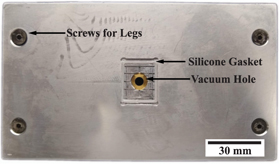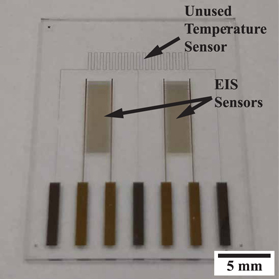In the recently published ‘3D printing on glass for direct sensor integration,’ authors M. Neubauer, M. McGlennen, S. Thomas and S. Warnat explore further methods for refining 3D printed microfluidics. In this study, the researchers create an approach for fabricating channels onto glass substrates.
As additive manufacturing processes become a realistic method for fabricating fluidic devices, using vat polymerization ( they abbreviate it VPP), stereolithography (SLA), and digital light processing (DLP), researchers have many different options before them for research like integration of sensors. Glass substrates offer a way for making channels that are not only optically transparent but offer a way to embed a glass-based impedance-conductivity sensor within the 3D printed flow channel.
For the 3D printing process, the researchers chose a MiiCraft 50, along with clear BV007 resin.

Modified build plate with insert for glass slide and silicone gasket and vacuum hole to hold glass substrate in place during printing.
“Using a silicone gasket and a diaphragm vacuum pump (Masis, GZ35-12) a glass slide could be held in place during the printing process and quickly released afterwards. The glass slide protruded slightly from the plane of the build plate; this distance was measured and accounted for in the printer software,” explained the researchers.
“Mounting the glass flush with the edge of the insert made it possible to reference the edge of the glass in the software so that prints could be precisely aligned to the edges of the glass itself with better than 100 μm repeatability.”
The research team selected sample applications to match the sensors, but they could also be used in a wide range of applications. The build plate, silane treatment, and more, could be used with other hardware and materials.
“The glass substrate is itself a part of the channel and allows ideal optical access. Resistance measurements, Raman spectroscopy, and impedance spectra show that sensor properties are unaffected, and no resin or chemicals are left on the sensing surface after printing on the sensor. Viability of materials other than Au could be tested for other applications with similar techniques,” concluded the researchers.
“Applying the same methods for device realization, any number of devices can be integrating with a 3D printed structure. The limitations on device design generally are associated with the 3D printer, its resolution and compatible resins. These issues will become less prevalent as the technology in this rapidly advancing field improves and becomes available. Overall, this process will benefit from all advances in 3D printing technologies, becoming an increasingly viable avenue for sensor-packaging integration for bio-sensing.”
3D printing microfluidics is becoming an extensive area of study, from analyzing and solving challenges within to exploring the connection with other materials and processes, to include bioprinting. What do you think of this news? Let us know your thoughts; join the discussion of this and other 3D printing topics at 3DPrintBoard.com.

Fabrication process and image of device. (a) Flow chart of device fabrication. (b) Exploded view of designed sensor packaging. (c) Assembled device with tubing and magnets.
Subscribe to Our Email Newsletter
Stay up-to-date on all the latest news from the 3D printing industry and receive information and offers from third party vendors.
You May Also Like
Wisconsin’s Evology Adds Digital Sheet Forming to Service Roster
Evology, a service bureau based in Wisconsin and specializing in serving strategic sectors like aerospace and defense, has added digital sheet forming (DSF) to its repertoire of manufacturing capabilities. Evology...
Boring Company Alum Score $9M for Advanced Composites Manufacturing
Layup Parts, a Huntington Beach, CA-based startup specializing in on-demand manufacturing of parts made from composites, has received $9 million in its latest financing round. Founders Fund, the VC firm...
Industrial Giant Ingersoll Rand Leads $19M Round Backing Inkbit’s AI-Driven 3D Printing
Inkbit, the Massachusetts-based original equipment manufacturer (OEM) of multi-material, AI-integrated 3D printers, has closed a $19 million financing round. Ingersoll Rand, a US giant in the industrial equipment sector, led...
3YOURMIND & Nigerian Oilfield Services Firm RusselSmith Team Up on 3D Printed Part Inventory
3YOURMIND, the German and U.S. software services provider specializing in digital inventory platforms for additive manufacturing (AM), has partnered with Nigerian oilfield services firm RusselSmith to digitize spare part files...

































